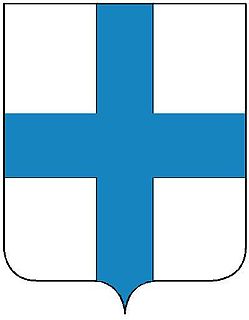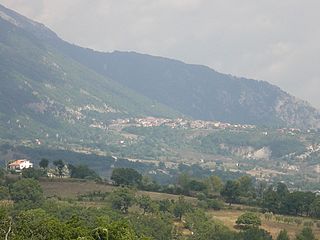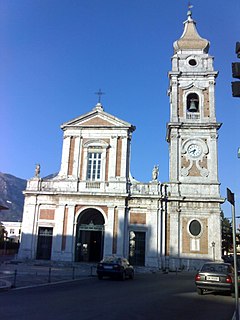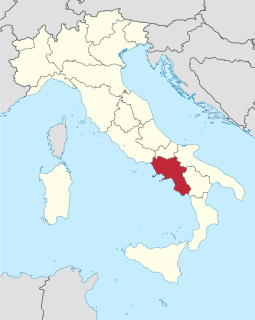History
The first human settlements in the territory date back to the Roman times. Many ruins have been found in the localities of Cesine, Vigna, Selvetelle, Scandravoli, Giardino, Ponticelli, Gaudi, Toppa S. Andrea. The name of the town derives from the Latin "locus candidus" which means clear, shining place.
The first historical mention of the town appeared in 1045 when Candida was included, under the Lombard domination, in the Avellino county. From that time many feudal lords followed one another. The Filangieri family owned the fiefdom from 1187 with Alduino de Candida, until 1420 when Caterina Filangieri de Candida gave the fiefdom of Candida as a dowry to Sergianni Caracciolo. Then the fiefdom passed to the De Cardona, Magnacervo, Grimaldi, Saulli families back to the Caracciolos that kept it until the abolition of the feudal system.

The Duchy of Benevento was the southernmost Lombard duchy in the Italian peninsula, centered on Benevento, a city in Southern Italy. Being cut off from the rest of the Lombard possessions by the papal Duchy of Rome, Benevento was practically independent from the start. Only during the reigns of Grimoald, King of the Lombards and the kings from Liutprand on was the duchy closely tied to the kingdom. After the fall of the kingdom, however, alone of Lombard territories it remained as a rump state, and maintained its de facto independence for nearly three hundred years, though it was divided after 849.

The Filangieri were an Italo-Norman noble family with origins (c.1100) near Nocera in the Kingdom of Sicily, but they rose to prominence at Naples. Famous members include:
AldoinoFilangieri di Candida was a nobleman in the Kingdom of Naples. He was the son of Giordano of the Filangieri and an unnamed woman, the sister of Aldoino di Cicala, after whom he was named and from whom he inherited his fief. He inherited his uncle's fief of Candida on his father's death. He was the father of the Filangieri di Candida.
This page is based on this
Wikipedia article Text is available under the
CC BY-SA 4.0 license; additional terms may apply.
Images, videos and audio are available under their respective licenses.

Avellino [avelˈliːno] listen (help·info) is a town and comune, capital of the province of Avellino in the Campania region of southern Italy. It is situated in a plain surrounded by mountains 47 kilometres (29 mi) east of Naples and is an important hub on the road from Salerno to Benevento.

Ponte is the name of a town and comune in the Province of Benevento, Campania Region, Italy. It is a member of the Titerno "Local Action Group" (GAL) and its name means bridge in Italian language.

San Benedetto in Perillis is a town and comune in the province of L'Aquila, Abruzzo, central Italy. The town is 43 kilometres (27 mi) from the regional capital, L'Aquila.

Pietradefusi is a comune in the province of Avellino, Campania, Italy.

Chianche is a town and comune in province of Avellino, in the Campania region of Italy.

Monteroni di Lecce is a town and comune in the province of Lecce, in Puglia in southern Italy. In 2008 it had 13,800 inhabitants. It is 7 kilometres (4 mi) from Lecce, in the Salento – the historic Terra d'Otranto.

Nusco is a town and comune in the province of Avellino in the south of Italy, east of Naples, with c. 4,100 inhabitants. It is situated in the mountains between the valleys of the Calore Irpino and Ofanto Rivers.

Lacedonia is a comune in the province of Avellino, southern Italy, overlooking the Osento River which flows into the Lago di San Pietro, an artificial lake. The town is part of the Roman Catholic Diocese of Ariano Irpino-Lacedonia.

Montemarano is a town and comune, former Latin bishopric and present titular see in the province of Avellino in the Campania region of southern Italy.

Andretta is a town and comune in the province of Avellino, Campania, Italy.

Castel Baronia is a town and comune in the province of Avellino, Campania, southern Italy. It rises 639 metres (2,096 ft) above the sea level.

Cervinara is a town and comune in the province of Avellino, Campania, southern Italy.

Manocalzati is a town and comune in the province of Avellino, Campania, Southern Italy. The area produces chestnuts, nuts and grapes.

Montefredane is a comune in the province of Avellino, Campania, southern Italy.

Senerchia is an Italian municipality with 1370 registered voters, but only 1036 inhabitants, in the Province of Avellino, located in the upper valley of the Sele River in Campania. It was the site of the defeat of Spartacus and is noted for the ruins of an ancient castle.

Tocco da Casauria is a comune and town in the Province of Pescara in the Abruzzo region of Central Italy.

Grottole is a town and comune in the province of Matera, in the region of Basilicata in southern Italy.

Riccia is a comune (municipality) in the Province of Campobasso in the Italian region Molise, located about 15 kilometres (9 mi) southeast of Campobasso, with a population of about 5,600.

Robbio is a city and comune (municipality) in the Province of Pavia in the Italian region Lombardy, located about 50 km southwest of Milan and about 45 km west of Pavia. It is part of Lomellina traditional region.
Robbio borders the following municipalities: Borgolavezzaro, Castelnovetto, Confienza, Nicorvo, Palestro, Rosasco, Vespolate.

Airola is a comune (municipality) in the Province of Benevento in the Italian region Campania, located about 35 km northeast of Naples and about 20 km southwest of Benevento in the Valle Caudina, facing the Monte Taburno. Nearby is the confluence of the Tesa and Faenza streams into the Isclero River. Airola's territory is also crossed by the Acquedotto Carolino, carrying waters to the Caserta Palace.

















